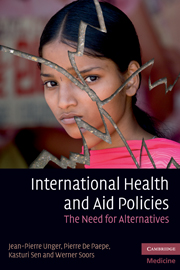Book contents
- Frontmatter
- Contents
- Preface
- Biographies
- Notices
- Acknowledgements
- List of abbreviations
- Reviews
- Introduction: Overview and purpose
- Section 1 Paradigms of international policies
- Section 2 The failure of the aid paradigm: poor disease control in developing countries
- 3 Why do disease-control programmes require patients in health services to succeed in delivering? The case of malaria control in Mali
- 4 How do disease-control programmes damage health care delivery in developing countries?
- 5 Privatization (PPM-DOTS) strategy for tuberculosis control: how evidence-based is it?
- Section 3 Impact of international health policies on access to health in middle-income countries: some experiences from Latin America
- Section 4 Determinants and implications of new liberal health policies: the case of India, China and Lebanon
- Section 5 Principles for alternative, publicly oriented health care policies, planning, management and delivery
- Section 6 A public health, strategic toolkit to implement these alternatives
- Conclusions
- Glossary
- Index
- References
3 - Why do disease-control programmes require patients in health services to succeed in delivering? The case of malaria control in Mali
Published online by Cambridge University Press: 06 December 2010
- Frontmatter
- Contents
- Preface
- Biographies
- Notices
- Acknowledgements
- List of abbreviations
- Reviews
- Introduction: Overview and purpose
- Section 1 Paradigms of international policies
- Section 2 The failure of the aid paradigm: poor disease control in developing countries
- 3 Why do disease-control programmes require patients in health services to succeed in delivering? The case of malaria control in Mali
- 4 How do disease-control programmes damage health care delivery in developing countries?
- 5 Privatization (PPM-DOTS) strategy for tuberculosis control: how evidence-based is it?
- Section 3 Impact of international health policies on access to health in middle-income countries: some experiences from Latin America
- Section 4 Determinants and implications of new liberal health policies: the case of India, China and Lebanon
- Section 5 Principles for alternative, publicly oriented health care policies, planning, management and delivery
- Section 6 A public health, strategic toolkit to implement these alternatives
- Conclusions
- Glossary
- Index
- References
Summary
Adapted from: Unger J.-P., d'Alessandro U., De Paepe P., Green A. Can malaria be controlled where basic health services are not used? Tropical Medicine and International Health 2006; 11(3): 314–322.
Introduction
In this chapter, we aim to demonstrate that successful implementation of disease-control programmes requires health facilities that are being used by patients. Intuitively these patients, presenting with various symptoms, represent a pool of users that the programmes require for early case detection and adequate follow-up. We assess the potential of integrating malaria control interventions in basic health services with low levels of utilization of curative care. To do so we examined the expected malaria cure rate with a predictive model that includes parameters influencing access to anti-malarial treatment at home and in health facilities. The parametric values were selected from published African programmes that gave the best results. They were applied to the population in a district in Mali (Yanfolila), where the health-seeking behaviour of mothers/guardians with children with a fever had been quantified over a period in time.
One important component of the malaria control strategy promoted by WHO (Brugha et al., 2002; World Health Organization, 2003) is that of having adequate case management (early diagnosis and prompt and effective treatment). The cost-effectiveness of improvement in case management has been estimated around USD 1–8 per disease-adjusted life years averted.
- Type
- Chapter
- Information
- International Health and Aid PoliciesThe Need for Alternatives, pp. 37 - 47Publisher: Cambridge University PressPrint publication year: 2010
References
- 1
- Cited by

